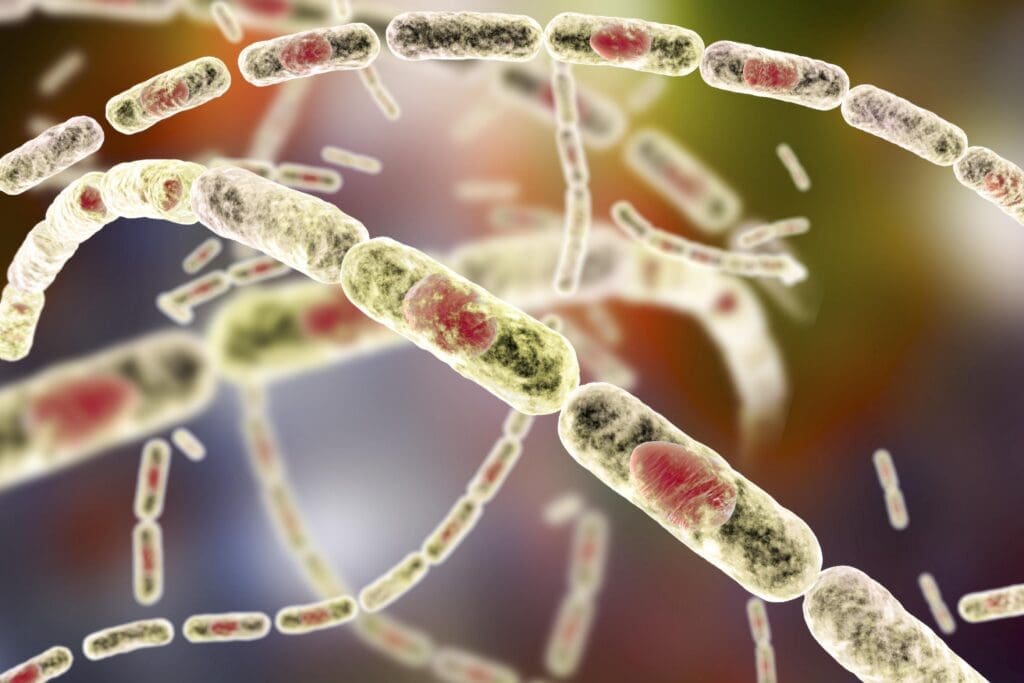
Anthracinum
Latin name: Anthracinum
Short name: Anthr
Common name: Anthrax Nosode | Carbuncle Poison | Anthrax Virus
Primary miasm: Sycotic Secondary miasm(s): Psoric
Kingdom: Nosodes
Family: Bacterial disease product (Bacillus anthracis)
- Symptomatology
- Remedy Information
- Differentiation & Application
Anthracinum is a nosode prepared from the purulent discharge and tissues of anthrax-infected animals. Anthrax is caused by Bacillus anthracis, a Gram-positive, spore-forming bacterium producing potent exotoxins. The remedy is potentised after thorough sterilisation and trituration, rendering it safe for homeopathic use while retaining its dynamic properties.
None in crude form due to its highly infectious and dangerous nature. In conventional medicine, anthrax infection is managed with antibiotics and vaccines; Anthracinum is strictly a homeopathic nosode with no orthodox medicinal application.
No traditional Hahnemannian proving due to the extreme virulence of the crude substance. Symptoms derive from clinical experience, toxicological observation, and cases of natural infection treated homeopathically by Dr. W. Lux, Dr. Burnett, and others.
- Skin and subcutaneous tissue – boils, carbuncles, malignant pustules, necrosis.
- Lymphatic system – rapid swelling, adenitis.
- Blood – septic conditions, putrid discharges.
- Digestive tract – septic diarrhoea.
- Respiratory system – septic pneumonia, malignant sore throat.
- Nervous system – septic shock, collapse, prostration.
- Discharges becoming free and less offensive.
- Local warmth when there is chilliness.
- Rest in septic collapse (slightly eases exhaustion).
- Suppression of discharges.
- Handling or pressure on affected part.
- Cold and damp (aggravates septic processes).
- Injury or inoculation of septic material.
- Arsenicum album – Restlessness and anxiety prominent; in Anthracinum, the anxiety is dull, with more putridity.
- Carbo vegetabilis – Collapse with coldness; Anthracinum has more malignant local lesions.
- Pyrogenium – Septicaemia with fever and restlessness; Anthracinum focuses more on malignant carbuncles and gangrene.
- Complementary: Arsenicum album, Pyrogenium.
- Antidotes: Lachesis (to septic skin lesions).
- Inimical: None recorded.
Embodies the destructive, putrid forces of septic disease. It is the nosode of malignant local and systemic infection, with a keynote of rapid tissue disintegration. Patients are profoundly weak, apathetic, and poisoned from within, with visible blackening of tissues.
Indispensable in carbuncles, malignant pustules, septicaemia, and gangrene when other remedies fail. Often used when Pyrogenium covers the systemic symptoms but the local destruction is more pronounced.
Mind
- Indifference during severe illness.
- Despair of recovery.
- Apathy with prostration.
- Stupor in septic states.
- Fear of death absent despite grave illness.
Head
- Headache from septic toxaemia.
- Heaviness of head.
- Stupor alternating with muttering.
- Brain congestion in fever.
- Vertigo from exhaustion.
Eyes
- Sunken, glassy eyes.
- Yellow sclera in septicaemia.
- Oedema of lids.
- Dull vision in fever.
- Discharges acrid and offensive.
Stomach
- Nausea in septic states.
- Retching without relief.
- Aversion to all food.
- Burning in stomach during fever.
- Offensive eructations.
Skin
- Malignant pustules, black centre.
- Carbuncles discharging black pus.
- Gangrene with dusky redness.
- Rapidly spreading ulcers.
- Oedema around pustules.
Extremities
- Cold, clammy limbs in collapse.
- Oedematous swelling in infection.
- Gangrene of extremities.
- Weakness preventing standing.
- Trembling from exhaustion.
Generalities
- Putrid discharges from all outlets.
- Rapid tissue destruction.
- Prostration extreme.
- Septic fever with collapse.
- Pain burning, stinging, throbbing.
Clarke, J. H. – Noted mental indifference, malignant carbuncles, and septic fevers in Anthracinum.
Hering, C. – Documented stupor, muttering, and abdominal symptoms from septic toxaemia.
Hughes, R. – Detailed malignant pustule pathology and black discharges.
Kent, J. T. – Discussed rapid tissue destruction and putrid secretions as keynote.
Burnett, J. C. – Clinical cures of carbuncles and anthrax with nosode potencies.
